Integrating a Hybrid Back Propagation Neural Network and Particle Swarm Optimization for Estimating Soil Heavy Metal Contents Using Hyperspectral Data
Abstract
:1. Introduction
2. Materials and Methods
2.1. Study Site and Data
2.2. Experimental Data Pre-Processing
2.2.1. Chemical Analysis of Soil Properties
2.2.2. Spectral Measurements and Pre-Processing of Soil Samples
2.3. Image Acquisition and Preprocessing
2.4. Selection of Optimum Spectral Variables
2.5. The BPNN Method to Estimate Soil Heavy Metal Contents
2.6. The PSO-BPNN Method to Estimate Soil Heavy Metal Contents
3. Results
3.1. Descriptive Statistics of Soil Properties in the Study Area
3.2. Smoothing Spectral Data of Soil Heavy Metal Contents
3.3. Optimal Spectral Variables for Retrieving Soil Heavy Metal Contents
3.4. Estimation and Accuracy Validation of Soil Heavy Metal Contents for Soil Sample Points
3.5. Estimation and Accuracy Validation of Soil Heavy Metal Contents at the Regional Scale
4. Discussion
5. Conclusions
Author Contributions
Funding
Conflicts of Interest
References
- Mouazen, A.; Maleki, M.; De Baerdemaeker, J.; Ramon, H. On-line measurement of some selected soil properties using a VIS-NIR sensor. Soil Tillage Res. 2007, 93, 13–27. [Google Scholar] [CrossRef]
- Jarmer, T.; Vohland, M.; Lilienthal, H.; Schnug, E. Estimation of some chemical properties of an agricultural soil by spectroradiometric measurements. Pedosphere 2008, 18, 163–170. [Google Scholar] [CrossRef]
- Tan, K.; Ye, Y.; Cao, Q.; Du, P.; Dong, J. Estimation of arsenic contamination in reclaimed agricultural soils using reflectance spectroscopy and ANFIS method. IEEE J.-STARS 2014, 7, 2540–2546. [Google Scholar]
- Wu, D.W.; Wu, Y.Z.; Ma, H.R. Study on the prediction of soil heavy metal elements content based on Mid-Infrared diffuse reflectance spectra. Spectrosc. Spectr. Anal. 2009, 29, 114. [Google Scholar]
- Kooistra, L.; Wanders, J.; Epema, G.; Leuven, R.; Wehrens, R.; Buydens, L. The potential of field spectroscopy for the assessment of sediment properties in river floodplains. Anal. Chim. Acta 2003, 484, 189–200. [Google Scholar] [CrossRef]
- Lian, S.; Jian, J.; Tan, D.J.; Xie, H.B.; Luo, Z.F.; Gao, B. Estimate of heavy metals in soil and streams using combined geochemistry and field spectroscopy in Wansheng mining area, Chongqing, China. Int. J. Appl. Earth. Obs. 2015, 34, 1–9. [Google Scholar]
- Lu, P.; Wang, L.; Niu, Z.; Li, L.; Zhang, W. Prediction of soil properties using laboratory VIS-NIR spectroscopy and Hyperion imagery. J. Geochem. Explor. 2013, 132, 26–33. [Google Scholar] [CrossRef]
- Kemper, T.; Sommer, S. Estimate of heavy metal contamination in soil after a mining accident using reflectance spectroscopy. Environ. Sci. Technol. 2002, 36, 2742–2747. [Google Scholar] [CrossRef] [PubMed]
- He, J.L.; Jiang, J.J.; Zhou, S.L.; Xu, J.; Cai, H.L.; Zhang, C.Y. The hyperspectral characteristics and retrieval of soil organic matter content. Sci. Agric. Sin. 2007, 40, 638–643. [Google Scholar]
- Zhang, Q.X.; Zhang, H.B.; Liu, W.K.; Zhao, S.X. Inversion of heavy metals content with hyperspectral reflectance in soil of well-facilitied capital farmland construction areas. Trans. Chin. Soc. Agric. Eng. 2017, 33, 230–239. [Google Scholar]
- Ghadimi, F. Prediction of heavy metals contamination in the groundwater of Arak region using artificial neural network and multiple linear regression. J. Tethys. 2015, 3, 203–215. [Google Scholar]
- Gandhimathi, A.; Meenambal, T. Spatial prediction of heavy metal pollution for soils in Coimbatore, India based on ANN and kriging method. Eur. Sci. J. 2012, 8, 1857. [Google Scholar]
- Guo, Y.K.; Liu, L.; Liu, N.; Zhu, S.T.; Li, D. The prediction of the heavy metal Fe content in rice field based on support vector machine regression. Beijing Surv. Map. 2017, 6, 10–13. [Google Scholar]
- Guo, Z.X.; Wang, J.; Chai, M.; Chen, Z.P.; Zhan, Z.S.; Zheng, W.P.; Wei, X.G. Spatiotemporal variation of soil pH in Guangdong Province of China in past 30 years. Chin. J. Appl. Ecol. 2011, 22, 425–430. [Google Scholar]
- Chang, C.W.; Laird, D.A.; Mausbach, M.J.; Hurburgh, C.R., Jr. Near-infrared reflectance spectroscopy-principal components regression analyses of soil properties. Soil Sci. Soc. Am. J. 2001, 65, 480–490. [Google Scholar] [CrossRef]
- Kooistra, L.; Wehrens, R.; Leuven, R.; Buydens, L. Possibilities of visible-near-infrared spectroscopy for the assessment of soil contamination in river floodplains. Anal. Chim. Acta 2001, 446, 97–105. [Google Scholar] [CrossRef]
- Wang, J.J.; Cui, L.J.; Gao, W.X.; Shi, T.Z.; Chen, Y.; Gao, Y. Prediction of low heavy metal concentrations in agricultural soils using visible and near-infrared reflectance spectroscopy. Geoderma 2014, 216, 1–9. [Google Scholar] [CrossRef]
- Gomez, C.; Lagacherie, P.; Coulouma, G. Continuum removal versus PLSR method for clay and calcium carbonate content estimation from laboratory and airborne hyperspectral measurements. Geoderma 2008, 148, 141–148. [Google Scholar] [CrossRef]
- Wu, Y.; Chen, J.; Wu, X.; Tian, Q.; Ji, J.; Qin, Z. Possibilities of reflectance spectroscopy for the assessment of contaminant elements in suburban soils. Appl. Geochem. 2005, 20, 1051–1059. [Google Scholar] [CrossRef]
- Tian, H.J.; Cao, C.X.; Xu, M.; Zhu, Z.C.; Liu, D.; Liu, D.; Wang, X.Q.; Cui, S.H. Estimation of chlorophyll-a concentration in coastal waters with HJ-1A HSI data using a three-band bio-optical model and validation. Int. J. Remote Sens. 2014, 35, 5984–6003. [Google Scholar] [CrossRef]
- Anne, N.J.P.; Abd-Elrahman, A.H.; Lewis, D.B.; Hewitt, N.A. Modeling soil parameters using hyperspectral image reflectance in subtropical coastal wetlands. Int. J. Appl. Earth Obs. Geoinform. 2014, 33, 47–56. [Google Scholar] [CrossRef]
- Gómez, R.S.; Pérez, J.G.; Martín, M.D.L.; García, C.G. Collinearity diagnostic applied in ridge estimation through the variance inflation factor. J. Appl. Stat. 2016, 43, 19. [Google Scholar]
- Wu, J.H.; Wang, G.L.; Wang, J.; Su, Y. BP neural network and multiple linear regression in acute hospitalization costs in the comparative study. J. Fluid Mech. 2011, 5, 50–51. [Google Scholar] [CrossRef]
- Yu, X.; Efe, M.O.; Kaynak, O. A general backpropagation algorithm for feedforward neural network learning. IEEE Trans. Neural Netw. 2002, 13, 251–254. [Google Scholar] [PubMed]
- Kennedy, J.; Eberhart, R. Particle Swarm Optimization. In Proceedings of the Fourth IEEE International Conference on Neural Networks, Perth, Australia, 27 November–1 December 1995; Volume 4, pp. 1942–1948. [Google Scholar]
- Singh, A.N. Estimation of as and cu contamination in agricultural soils around a mining area by reflectance spectroscopy: A case study. Pedosphere 2009, 9, 719–726. [Google Scholar]
- Liu, M.; Liu, X.; Li, M.; Fang, M.; Chi, W. Neural-network model for estimating leaf chlorophyll concentration in rice under stress from heavy metals using four spectral indices. Biosyst. Eng. 2010, 106, 223–233. [Google Scholar] [CrossRef]
- Pandit, C.; Filippelli, G.; Lin, L. Estimation of heavy-metal contamination in soil using reflectance spectroscopy and partial least-squares regression. Int. J. Remote Sens. 2010, 31, 13. [Google Scholar] [CrossRef]
- Wang, F.; Gao, J.; Zha, Y. Hyperspectral sensing of heavy metals in soil and vegetation: Feasibility and challenges. ISPRS J. Photogramm. Remote Sens. 2018, 136, 73–84. [Google Scholar] [CrossRef]
- Khosravi, V.; Ardejani, F.D.; Yousefi, S.; Aryafar, A. Monitoring soil lead and zinc contents via combination of spectroscopy with extreme learning machine and other data mining methods. Geofis. Int. 2018, 318, 29–41. [Google Scholar] [CrossRef]
- Luo, H.; Zheng, Y. The comparison of citrus canopy spectral characteristics obtained by the HJ-1A/ HSI and ASD field spectrometer. In Proceedings of the 9th IEEE International Conference on Fuzzy Systems and Knowledge Discovery, Sichuan, China, 29–31 May 2012; pp. 650–655. [Google Scholar]
- Sadr, M.H.; Astaraki, S.; Salehi, S. Improving the neural network method for finite element model updating using homogenous distribution of design points. Arch. Appl. Mech. 2007, 77, 795–807. [Google Scholar] [CrossRef]
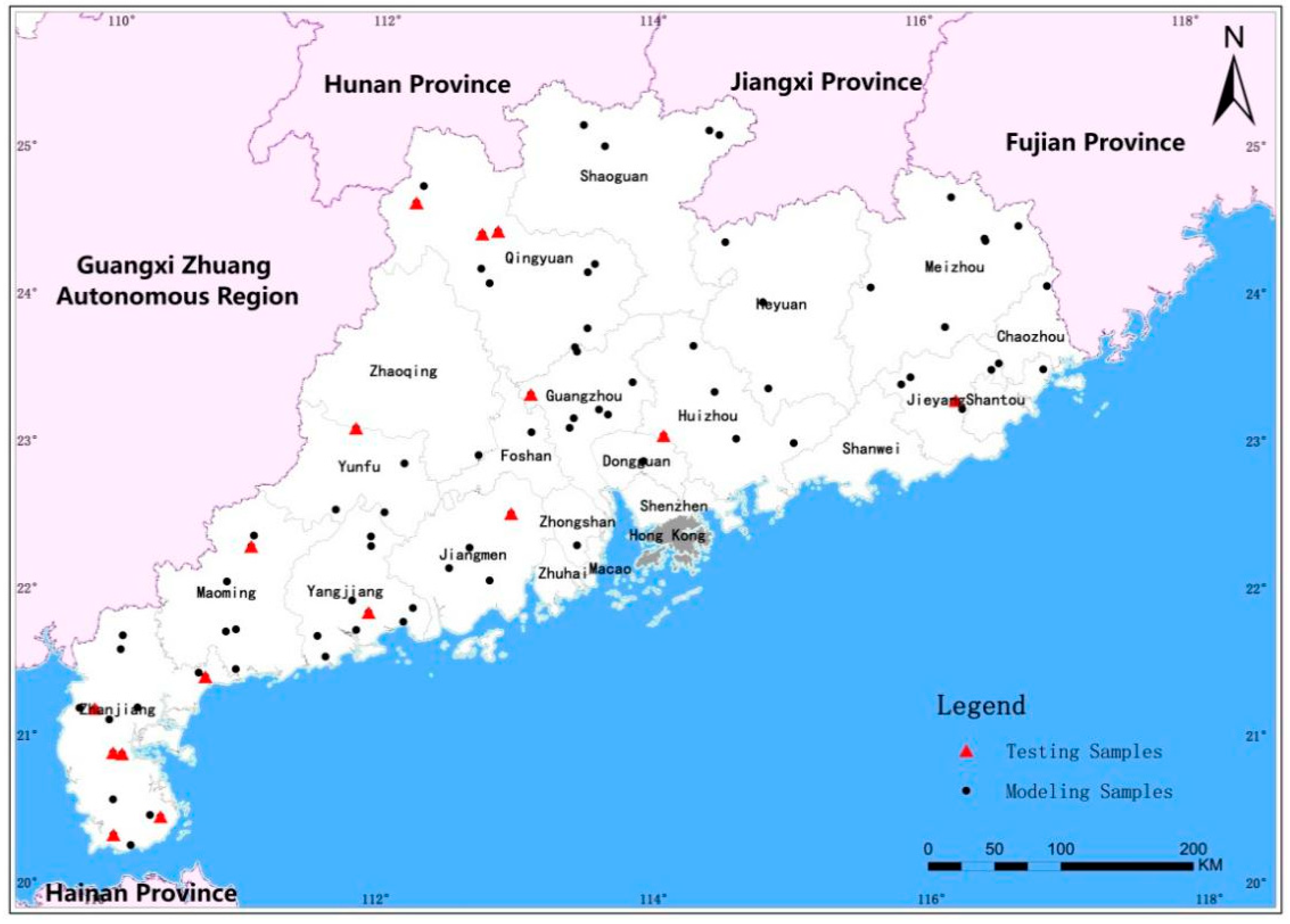
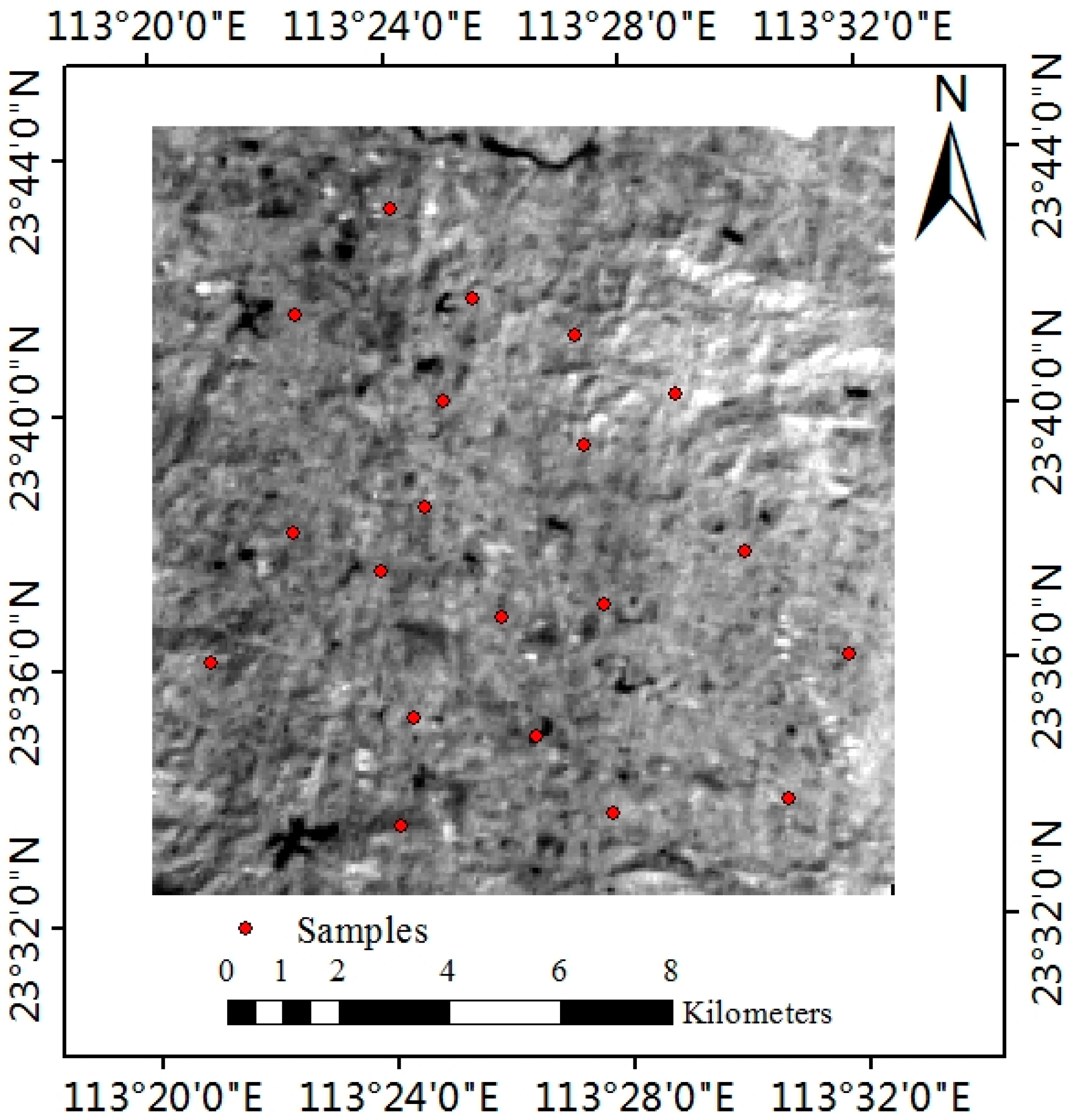
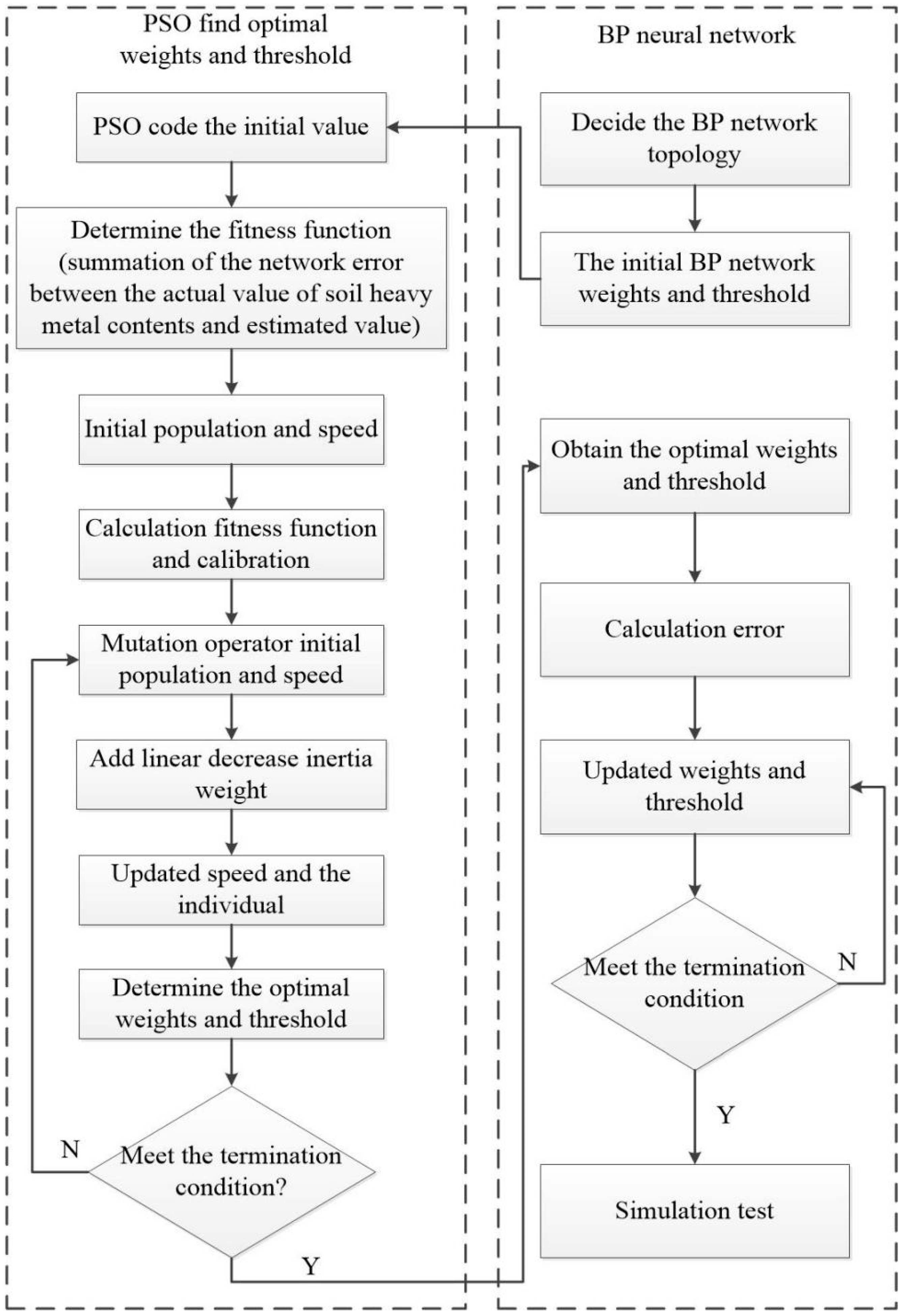
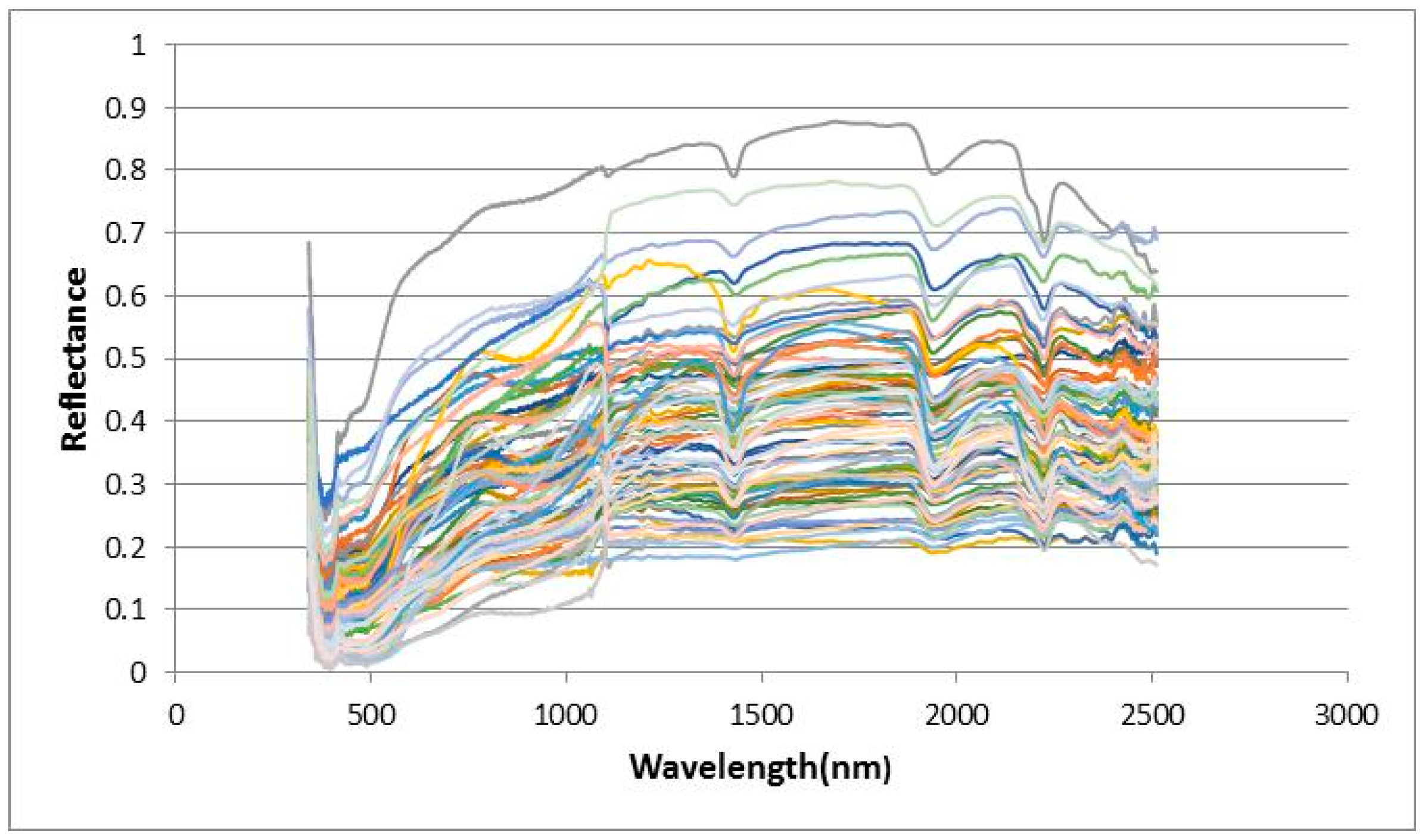
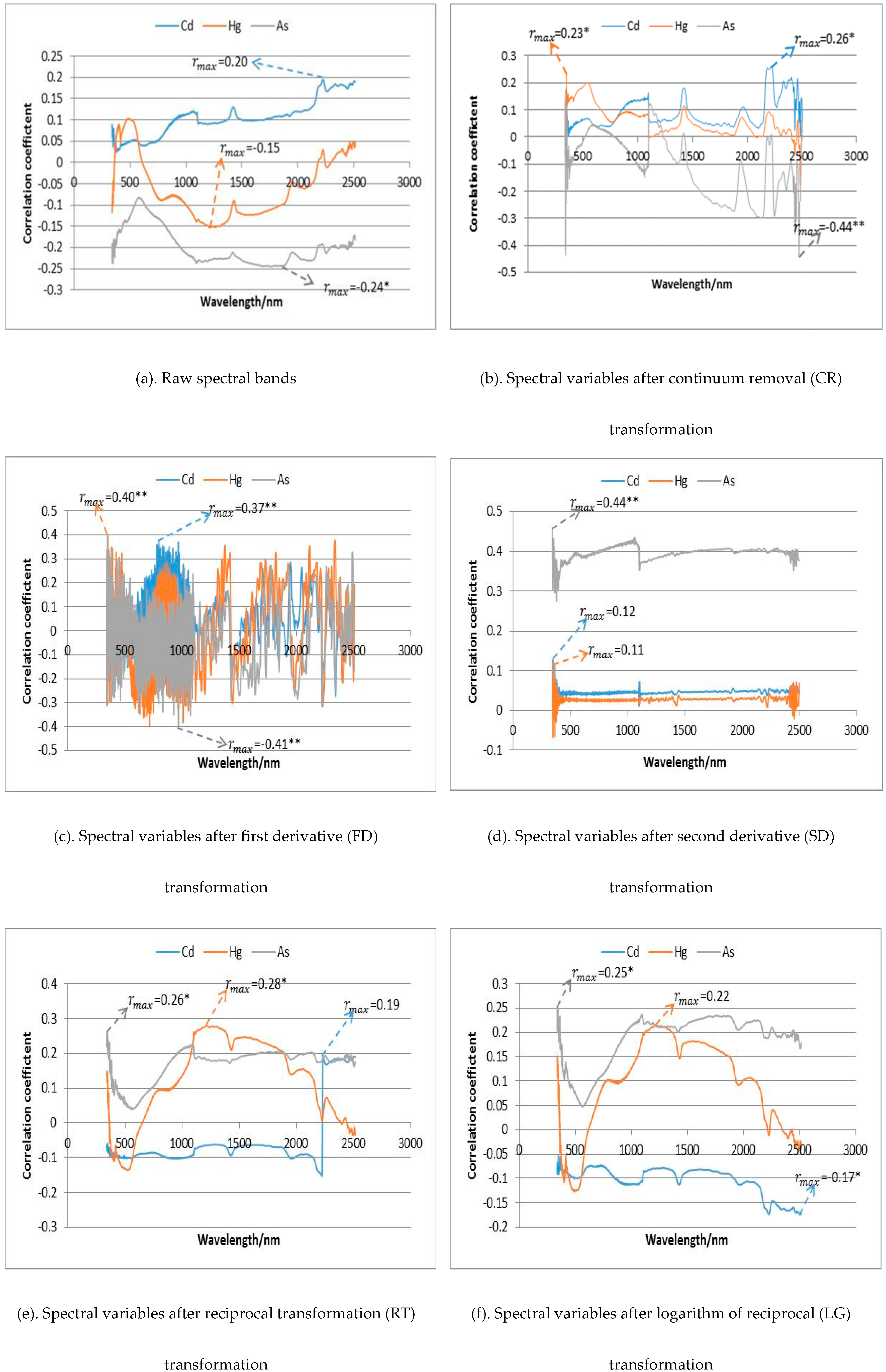


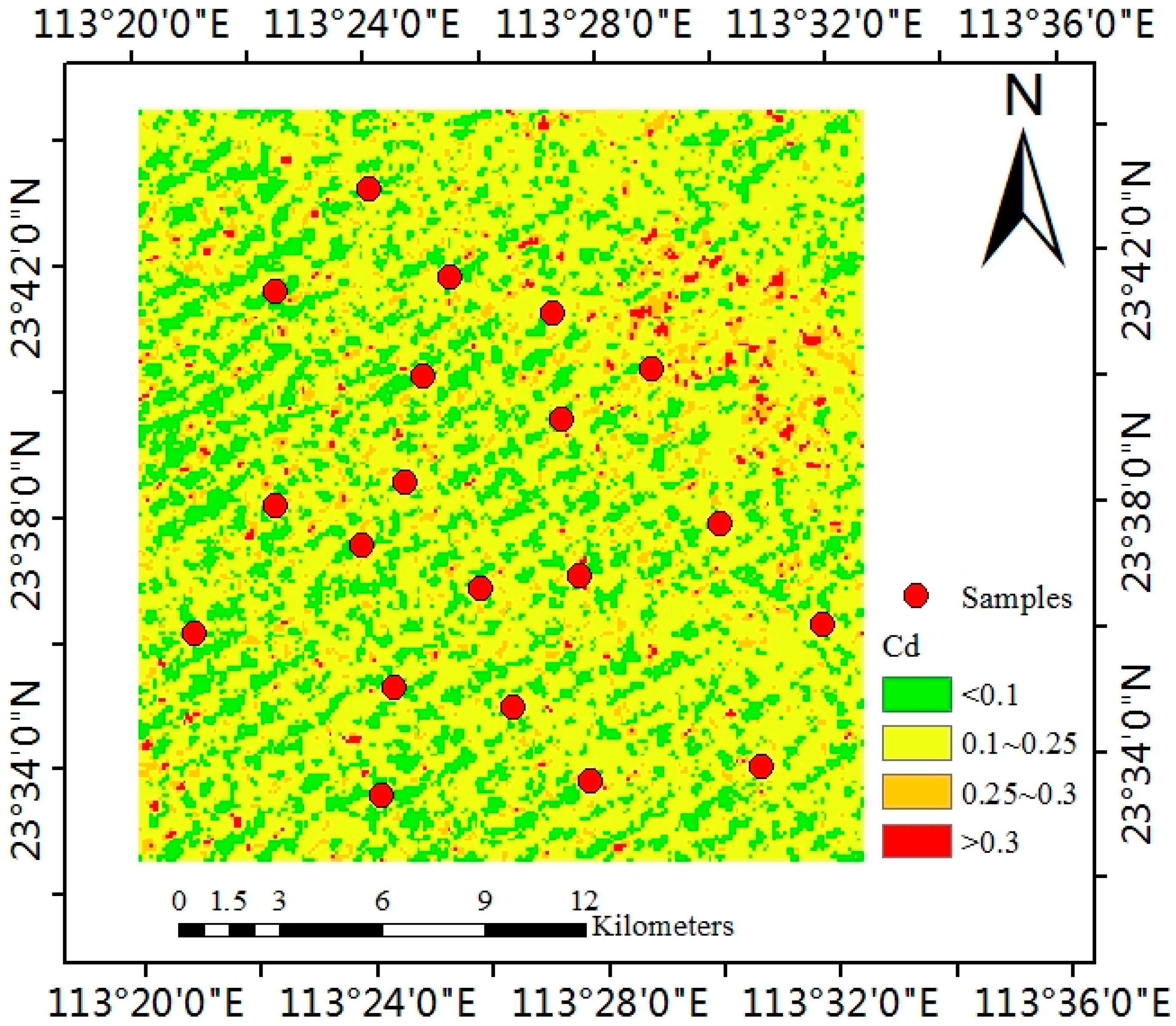
| Metal (mg/kg) | Minimum | Maximum | Mean | SD | CV (%) | Background Value | Standard |
|---|---|---|---|---|---|---|---|
| Cd | 0.003 | 0.570 | 0.174 | 0.111 | 63.79 | 0.034 | 0.3 |
| Hg | 0.026 | 0.310 | 0.132 | 0.085 | 64.44 | 0.078 | 0.3 |
| As | 1.370 | 68.600 | 9.761 | 7.487 | 76.70 | 10.50 | 30 |
| Heavy Metal | Spectral Parameters | Combinations of Spectral Variables | r |
|---|---|---|---|
| Cd | Raw Reflectance (R) | R1089.379 *R2222.424 | 0.36 ** |
| First Derivative (FD) | FD938.753 *FD795.231 | 0.60 ** | |
| Second Derivative (SD) | SD346.839 *SD808.196 | −0.54 ** | |
| Logarithm of Reciprocal (LG) | LG784.504/LG492.442 | 0.42 ** | |
| Reciprocal Transformation (RT) | RT2253.954/RT2228.733 | 0.40 ** | |
| Continuum Removal (CR) | CR348.024 − CR2222.424 | −0.48 ** | |
| Hg | Raw Reflectance (R) | R2222.424/R1219.677 | 0.38 ** |
| First Derivative (FD) | FD1373.48 + 7 *FD430.21 | 0.58 ** | |
| Second Derivative (SD) | 30 *SD356.912 − 25 *SD348.024 | −0.43 ** | |
| Logarithm of Reciprocal (LG) | LG2222.424 − LG1212.22 | −0.47 ** | |
| Reciprocal Transformation (RT) | 7 *RT2222.424–12 *RT1212.22 | −0.42 ** | |
| Continuum Removal (CR) | CR2486.193 − CR350.987 | −0.48 ** | |
| As | Raw Reflectance (R) | R347.431 + R1765.023 | −0.36 ** |
| First Derivative (FD) | FD2342.058/FD966.869 | −0.60 ** | |
| Second Derivative (SD) | 6 *SD363.425–5 *SD340.316 | −0.49 ** | |
| Logarithm of Reciprocal (LG) | LG345.653 − LG344.467 | −0.40 ** | |
| Reciprocal Transformation (RT) | RT343.291/RT343.874 | −0.49 ** | |
| Continuum Removal (CR) | CR344.467 − CR2473.69 | −0.54 ** |
| Heavy Metal | Combined Spectral Variables | Adjusted R2 | Estimation Error | F | Significance Level | Variance Inflation Factor |
|---|---|---|---|---|---|---|
| Cd | FD938.753*FD795.231, LG784.504/LG492.442 | 0.226 | 0.343 | 15.413 | 0.000 | 4.045 |
| Hg | FD1373.48 + 7*FD430.21, LG2222.424 − LG1212.22, 7*RT2222.424 − 12*RT1212.22 | 0.300 | 0.235 | 7.781 | 0.000 | 6.324 |
| As | FD2342.058/FD966.869, RT343.281/RT343.874, 6*SD363.425 − 5*SD340.316 | 0.312 | 7.874 | 15.427 | 0.000 | 5.006 |
| BPNN | PSO-BPNN | |||||
|---|---|---|---|---|---|---|
| Heavy Metal | R2 | Mean Relative Error (MRE) (%) | RRMSE (%) | R2 | MRE (%) | RRMSE (%) |
| Cd | 0.390 | 34.053 | 36.217 | 0.755 | 10.074 | 12.037 |
| Hg | 0.283 | 37.784 | 38.514 | 0.742 | 10.909 | 13.862 |
| As | 0.516 | 29.955 | 30.970 | 0.811 | 9.594 | 11.121 |
| Category | Maximum | Minimum | Mean | Standard Deviation | R2 | RRMSE (%) |
|---|---|---|---|---|---|---|
| Measured value | 0.218 | 0.068 | 0.137 | 0.044 | 0.656 | 35.989 |
| Estimated value | 0.249 | 0.032 | 0.122 | 0.053 |
© 2019 by the authors. Licensee MDPI, Basel, Switzerland. This article is an open access article distributed under the terms and conditions of the Creative Commons Attribution (CC BY) license (http://creativecommons.org/licenses/by/4.0/).
Share and Cite
Liu, P.; Liu, Z.; Hu, Y.; Shi, Z.; Pan, Y.; Wang, L.; Wang, G. Integrating a Hybrid Back Propagation Neural Network and Particle Swarm Optimization for Estimating Soil Heavy Metal Contents Using Hyperspectral Data. Sustainability 2019, 11, 419. https://doi.org/10.3390/su11020419
Liu P, Liu Z, Hu Y, Shi Z, Pan Y, Wang L, Wang G. Integrating a Hybrid Back Propagation Neural Network and Particle Swarm Optimization for Estimating Soil Heavy Metal Contents Using Hyperspectral Data. Sustainability. 2019; 11(2):419. https://doi.org/10.3390/su11020419
Chicago/Turabian StyleLiu, Piao, Zhenhua Liu, Yueming Hu, Zhou Shi, Yuchun Pan, Lu Wang, and Guangxing Wang. 2019. "Integrating a Hybrid Back Propagation Neural Network and Particle Swarm Optimization for Estimating Soil Heavy Metal Contents Using Hyperspectral Data" Sustainability 11, no. 2: 419. https://doi.org/10.3390/su11020419
APA StyleLiu, P., Liu, Z., Hu, Y., Shi, Z., Pan, Y., Wang, L., & Wang, G. (2019). Integrating a Hybrid Back Propagation Neural Network and Particle Swarm Optimization for Estimating Soil Heavy Metal Contents Using Hyperspectral Data. Sustainability, 11(2), 419. https://doi.org/10.3390/su11020419







